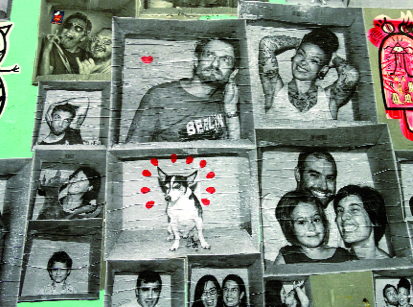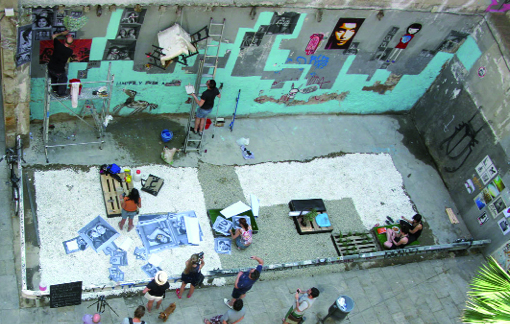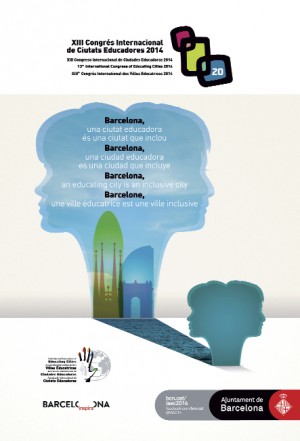When we speak of education, we are not only referring to teaching, but also to ways of living and of living together, to how time is spent, how newcomers are received, how noise is controlled, and so on. High quality education provision, whether it be formalised or not, when based on the principle of equal opportunities, can be a significant tool with which to counteract the phenomena of exclusion.

Images from the Encajados (Fitting in) exhibition, featuring photographs taken by Joan Tomàs of residents from the Sant Pere, Santa Caterina i la Ribera neighbourhood, on a piece of land on Carrer dels Canvis Nous in 2012.
Photo: Joan Tomàs
The preamble to the Charter of Educating Cities that was ratified at the 1st Congress, held in Barcelona in 1990, reminds us that cities offer countless opportunities for education – understood as the lifelong process of teaching and learning. We must not confuse education with schooling. The city is a permanent, plural, multifaceted educating agent capable of counteracting those forces that are inimical to education.
At the 13th International Congress of Educating Cities, which was held in Barcelona in 2014, it was proposed that these cities should be built on three basic pillars: inclusion, participation and innovation. Three cornerstones that mutually strengthen each other. Policies of inclusion that affect areas such as housing, employment, health, resources, education and the arts, encourage citizens to engage and participate through intercultural dialogue, networking, cooperation between different sectors and solidarity. As a consequence, the strengthening of community ties and cultural exchange give a boost to new ideas, talent, creativity, art and innovation. And, ultimately, all this brings benefits in the form of economic progress, driving learning and entrepreneurship, generating confidence and creating opportunities to share projects.
The challenge of exclusion
A common denominator of today’s cities is the growing rate of inequality and exclusion. This exclusion is related to different spheres – economic, political, cultural, relational, generational and gender – and it manifests itself in a series of circumstances: urban planning based on segregation, unequal education provision, chronic unemployment, cultural marginalisation, housing insecurity, lack of healthcare, poor access to transport, etc. But we must not forget that where there is a problem, there is also a solution. Cities do not only create negative effects; they can also be the best provider of social and democratic resources that bring about inclusion and cohesion.
Indeed, the actions of local authorities can have an impact on the causes of exclusion and they can change the social reality when they are based on values such as equity, solidarity, respect for difference and sustainable development, to build more cohesive and democratic societies that guarantee basic rights for all citizens. But if, in addition, the city is an educating one (in other words, it has consciously chosen to take on the role of educating agent), it strengthens and generates even more policies for public participation, employment and collaboration between all the social and educating agents it encompasses. It can make its actions democratically relevant and strengthen civic action, social inclusion and economic wealth.

Set up of the Encajados (Fitting in) exhibition on a piece of land on Carrer dels Canvis Nous in 2012. The plot of land was turned into an open space dedicated to artistic creation.
Photo: Joan Tomàs
Education does not only happen in schools; it also happens in the street and in the family. And when we speak of education, we are not only referring to teaching, but also to ways of living and of living together, to how time is spent, how newcomers are received, how noise is controlled, and so on. Clearly, high quality education provision, whether it be formalised or not, when based on the principle of equal opportunities, can be a significant tool with which to counteract the phenomena of exclusion, with successful results in the medium and long term. And in this context, schools play a key role because they are a source of knowledge and development of the personal competencies needed for life: a working laboratory for social and cultural diversity that can produce responsible, critical and engaged citizens.
Ultimately, educating cities are better prepared to fight for social cohesion. Their actions come from a particularly holistic perspective and a cross-functional focus, and are based on preventive and proactive policies to boost inclusion as much as possible and to put forward strong, decisive socio-educational proposals. At a time when the welfare state has gone into crisis, educating cities have been working hard to provide resources and to distribute them fairly; to use community and voluntary organisations to drive through inclusive policies that encompass the whole reality of the community and that are guided by the democratic principle of equality, rather than any form of paternalism; and to develop initiatives and urban projects that address the needs of the most vulnerable members of society, providing enough social services and public security forces that are efficient and respectful of human rights.
Community and identity
Only when the city includes, educates, works for equality and expresses solidarity are ties of trust and belonging forged; and, ultimately, only when community is created – the basic purpose of educating cities. But again, these ties can only be made and preserved (because we must be aware that they are fragile) by applying citizens’ real and universal rights to ensure that the contract between the public and the welfare state is met: sharing and preserving cultural and linguistic heritage; actively participating in the process of creating community associations; and making proper use of time and the public space.
Today, in philosophical and sociological circles, there is a premise that identities can be divided into at least two groups: individual and collective or community-based. To be able to talk about collective identities, two things are needed: a community that is more than the sum of its members (in this case, a city), and some basic common features that are shared by all its members – which are becoming increasingly harder to define in urban centres that are multicultural, multi-ethnic, multi-faith and multilingual. In fact, just as not all cities are educating cities, neither are all collective identities inclusive. It is up to the members to create systems to invite in or to close the door to new members. But, as we have already seen, the enshrinement of difference can be very dangerous.
That’s why in educating cities, it is very clear to us that the future hinges on reinforcing what joins the members of the community and not what separates them. However different people’s beliefs, political choices, geographical origins or social background are, the sooner we are able to emphasise their common elements, the sooner we can start to build a shared project. And that is not a by-word for homogenisation. A community identity does not have to suffocate individual identities, because in diversity there is wealth. If identity is the awareness that a person has of themselves, and what makes them unique, a city must also be able to ensure that all its members enjoy their individual identity with freedom and security.
To conclude: only the collective identity, the sum of all the points of connection between different individual identities, can make a city unique. And this is what educating cities are defending in point seven of their Charter: “The city must know how to discover, preserve and display its own complex identity. This will make it unique and provide the basis for a fruitful dialogue with its inhabitants and with other cities.”



